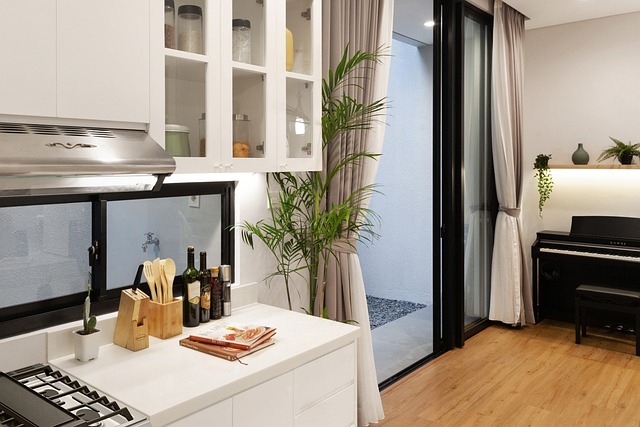When choosing kitchen flooring, prioritize durability and long-lasting quality. Popular options include water-resistant tile, hardwood floors, budget-friendly laminate, and versatile vinyl. Modern, sustainable choices like bamboo or cork also offer durability. These diverse kitchen flooring materials cater to aesthetics while ensuring functionality in high-traffic areas.
Looking to upgrade your kitchen with the perfect flooring? This guide offers expert insights into the best kitchen flooring options to suit every style and need. From durability and modern trends to water resistance and eco-friendliness, we explore a diverse range of materials. Discover long-lasting durable choices that handle high traffic, embrace tile’s design versatility, or opt for affordable vinyl. Learn about waterproof solutions for wet areas and sustainable options like bamboo. Elevate your kitchen with informed flooring decisions.
- Durable Kitchen Flooring Options for Longevity and Style
- – Exploring long-lasting materials
- – Benefits of durable flooring in high-traffic areas
- – Case studies: Successful installations
Durable Kitchen Flooring Options for Longevity and Style
When it comes to choosing kitchen flooring, durability is key. Your floor takes a lot of wear and tear from pots, pans, and everyday foot traffic. Investing in a long-lasting material ensures your space looks pristine for years to come. Thankfully, there’s an array of options that offer both style and sturdiness.
Tile and hardwood floors are popular choices for their timeless aesthetics and resilience. Tile flooring, with its water resistance, is ideal for kitchens, while hardwood adds warmth and elegance. For a more budget-friendly option, laminate mimics the look of wood without the cost. Vinyl is another versatile material that’s easy to maintain and comes in various designs, including those that resemble tiles or hardwood. If sustainability is a priority, consider eco-friendly materials like bamboo or cork, which are renewable resources known for their durability.
– Exploring long-lasting materials
When it comes to choosing kitchen flooring, durability is key. Opting for long-lasting materials ensures your space looks fresh and feels inviting for years to come. Among the many kitchen flooring options available, tile flooring for kitchens stands out for its waterproof qualities and ease of maintenance, making it an excellent choice for wet areas like countertops and backsplashes. Hardwood kitchen floors are another popular pick, offering both classic aesthetics and resilience, though they may require more frequent refinishing.
For those seeking modern kitchen floor materials that balance style and sustainability, eco-friendly options like laminate kitchen flooring and vinyl kitchen flooring offer durability and affordability without compromising on looks. Laminate, in particular, mimics the appearance of hardwood or stone at a fraction of the cost, while vinyl’s versatility allows for creative patterns and textures to complement any design aesthetic.
– Benefits of durable flooring in high-traffic areas
In high-traffic areas like kitchens, choosing durable kitchen flooring options is a wise decision. Kitchens often serve as the central hub of a home, experiencing constant foot traffic from cooking, cleaning, and entertaining. Durable floor materials can withstand this wear and tear while maintaining their aesthetic appeal for years to come. Tile flooring for kitchens, for instance, offers both style and practicality with its waterproof properties, making it an excellent choice for spaces prone to spills and moisture.
Hardwood kitchen floors have long been a popular modern kitchen floor material, known for their timeless elegance and ability to enhance the overall design of the space. Vinyl and laminate kitchen flooring also provide robust options that can mimic the look of wood or stone without the high cost and maintenance associated with natural materials. Moreover, eco-friendly kitchen floors are gaining traction, offering sustainable alternatives like bamboo or recycled materials that reduce environmental impact without sacrificing durability.
– Case studies: Successful installations
When exploring kitchen flooring options, case studies offer valuable insights into successful installations that have stood the test of time. For instance, tile flooring for kitchens has proven to be a popular and durable choice. Many homeowners opt for ceramic or porcelain tiles due to their water resistance, making them ideal for wet environments like bathrooms and kitchens. These tiles come in various styles, from classic subway patterns to modern hexagonal designs, catering to different aesthetic preferences.
Another notable case is the increasing adoption of eco-friendly kitchen floors. Laminate and vinyl flooring options are now available that mimic the look of hardwood or natural stone without the environmental impact. Vinyl, in particular, has gained traction for its durability, water resistance, and ease of maintenance—perfect for busy kitchens. Moreover, laminate flooring offers a cost-effective solution without compromising on style, with an extensive range of realistic wood grain and texture options to choose from.
When it comes to choosing the right kitchen flooring, opting for durable and stylish options ensures both functionality and aesthetics. From waterproof tiles to eco-friendly laminates, there’s a diverse range of materials available to suit every taste and budget. By considering high-traffic areas and incorporating modern designs, you can create a functional yet visually appealing space. Remember, the right kitchen flooring not only enhances your daily routine but also adds value to your home.
